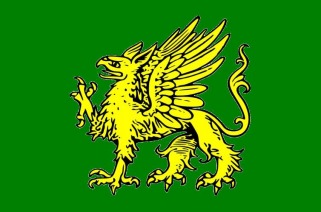Caldan Union
This article is incomplete because it is pending further input from participants, or it is a work-in-progress by one author. Please comment on this article's talk page to share your input, comments and questions. Note: To contribute to this article, you may need to seek help from the author(s) of this page. |
Caldan Union of the Resurgent Dream | |
|---|---|
|
Flag | |
Motto: Spem Reduxit | |
Anthem: "Caldas the Free" | |
| Capital | Tarana |
| Largest | Narich |
| Official languages | English |
| Recognised regional languages | Apatan, Arabic, Greek, Inuktitut, Scots, Welsh |
| Demonym(s) | Caldan |
| Government | Federal parliamentary constitutional monarchy |
• Queen | Gwendolyn |
| Lola Foster | |
| Legislature | Parliament |
| Senate | |
| House of Representatives | |
| Independent | |
• Coronation of Charles | 31 January 1788 |
• Union | 27 September 1839 |
| Population | |
• 2019 estimate | 317 million |
• 2016 census | 302 million |
| GDP (PPP) | estimate |
• Per capita | S250,451 (2,813th) |
| GDP (nominal) | estimate |
• Per capita | S250,451 (2,813th) |
| HDI | .97 very high · 2,002nd |
| Currency | Caldan Sterling (CLS) |
| Time zone | UTC-3 to -8 |
• Summer (DST) | UTC-2 to -7 |
| Date format | dd-mm-yyyy AD |
| Driving side | right |
| Calling code | +9 |
| Internet TLD | .cu |
The Caldan Union of the Resurgent Dream is a nation in the Western Atlantic. It consists of fourteen provinces. Ten are located in Vasconia, including the original six. These ten are known as historic or contiguous Caldas. The other four are located further south. The Gulf provinces became dominions in the 19th century and provinces in the 21st after dominion status was abolished. Two are located in Ambara and two in the Gulf of Vasconia. The capital of the Caldan Union is Tarana and its other major cities are Narich, Caer Gawen, Merotte, Marea, Fath, and St. Casimir. The northernmost regions of the Caldan Union contain sparsely populated expanses of tundra and forest while 81% of the Caldan population is concentrated in urban and suburban areas. The Caldan Union's climate varies significantly over its territory. Three Caldan provinces are arctic and sub-arctic, while two are tropical and two are comfortably in the southern hemisphere. The national capital is Tarana and the financial capital and largest city is Narich.
The earliest human inhabitants of what is now historic Caldas were the Apatan who arrived from the Sabari Steppes before 300 BCE. There is also evidence of some Germanic settlements in southern Tasat as early as 300 CE, related to the first Knootians. Camveni arrived in Tasat from Excalbia in 595 CE. Their ancestors had come from the British Isles. Their leader, Maddan married Hoelun, an Apatan princess and the daughter of Setsen, the locally predominant Apatan chieftain. Inuit peoples first arrived in northern Caldas in the 11th century. English and Scottish settlement began in the 16th century. Around the same time, French-speaking traders and trappers from the Southern Low Countries began to establish permanent settlements along the shores of Lake Hesperia in what is today Arcadia. After the Glorious Revolution in England and Scotland, most Caldans remained loyal to the Jacobite cause, leading to the Jacobite Wars in Vasconia. This led to conflict with Knootoss and to the newly emerging nation of Laneria to the south. A century later, Charles, a natural child of Charles III by Elizabeth Elwell, was the beneficiary of a deathbed legitimation which was accepted by the Parliaments of Anata and New Arundel as making him the rightful King of England and of Ireland and by the Parliament of Edina as making him the rightful King of Scotland. He was also invited to a royal title by the National Assembly of Arcadia and, by virtue of his marriage to Gwenhwyfar, Duchess of Tasat, the Prince Consort of Tasat. Lands west and north of the first Caldan provinces were later incorporated as provinces and Caldas one control of Dana and Hipolis in the Caldan-Lanerian War. Finara was added through a dynastic union and Jagiella and Alekthos in the aftermath of the Third Ambaran War.
The Caldan Union is a parliamentary democracy and constitutional monarchy in the Westminster tradition as codified in the Constitution of the Caldan Union. The Head of State is the Queen and the Head of Government is the prime minister, who holds office by virtue of their ability to command the confidence of the elected House of Representatives. It is an ethnically diverse and multicultural nation, where pluralist values are strong. Its history, economy, and culture have been significantly influenced by its closest neighbours, Knootoss and Laneria.
The Caldan Union is a developed country with one of the largest economies in the region and a high nominal per capita income. The Caldan economy includes natural resources, extensive trade networks, as well as a strong service sector and significant manufacturing capability.
